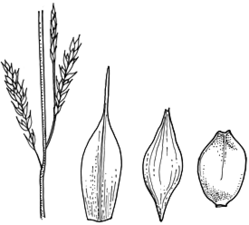Carex breviculmis R.Br. APNI* 
Description: Rhizome short; shoots densely tufted. Culms erect, terete to trigonous, smooth or scabrous, 3–10(-20) cm long, c. 0.7 mm diam.
Leaves exceeding culms, to 35 cm long; blade 2–3 mm wide; sheath yellow-brown; ligule obtuse to truncate.
Inflorescence erect, narrow, c. 4 cm long, with 2–5 spikes solitary at nodes; lowest involucral bract exceeding inflorescence. Spikes sessile, contiguous, erect at maturity, 1.2–1.8 cm long; uppermost spike male; lower spikes female. Glumes obtuse to acuminate, often long-mucronate (mucro to 2 mm long), whitish to pale brown with green midrib; female glumes 2.5–4.5 mm long. Perigynia (utricles) ellipsoid, prominently numerous-nerved, 2–3.3 mm long, 1.0–1.5 mm diam., hispid, pale green to yellow-brown; beak c. 0.5 mm long, with apex notched. Anthers 1.8–2.5 mm long excluding appendage to 0.1 mm long. Style 3-fid.
Nut obovoid to ellipsoid, trigonous in cross section, pale yellow, with enlarged disk-like junction with persistent style base.
Flowering: spring–summer.
Distribution and occurrence: All Coastal, Tablelands and Western Slopes regions, and LHI; widespread in eastern Australia; also in New Zealand, Malesia, Asia. Grows in grassland and open woodland (rather dry sites) especially on tablelands.
NSW subdivisions: NC, CC, SC, NT, CT, ST, NWS, CWS, SWS, LHI
Other Australian states: Qld Vic. Tas.
Text by K. L. Wilson (1993); edited KL Wilson (Nov 2007, June 2009, Nov 2011, July 2016)
Taxon concept: Flora of NSW 4 (1993)
APNI* Provides a link to the Australian Plant Name Index (hosted by the Australian National Botanic Gardens) for comprehensive bibliographic data
***The AVH map option provides a detailed interactive Australia wide distribution map drawn from collections held by all major Australian herbaria participating in the Australian Virtual Herbarium project.
|


